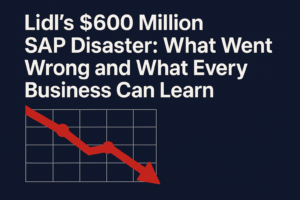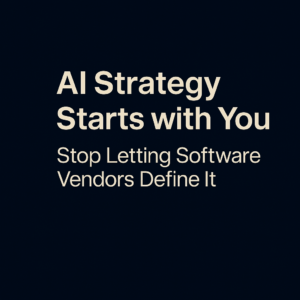Artificial Intelligence (AI) is revolutionizing business as we know it. From improving efficiency and decision-making to enhancing customer experiences, AI is rapidly becoming a cornerstone of modern enterprise operations. Yet, amid all the excitement and optimism, there lies a lesser-known—but critically important—risk that businesses must grapple with:
In the race to adopt AI, many organizations may be unknowingly giving away their competitive edge.
This blog explores how enterprise contracts, particularly those tied to ERP and cloud software platforms, may be exposing businesses to long-term strategic disadvantages—especially in the era of AI. We’ll dive deep into how this happens, why it’s more serious than it sounds, and what companies can do to protect themselves before it’s too late.
Table of Contents
ToggleThe Evolving Landscape of AI and ERP Contracts
Let’s start with a simple truth: AI is only as powerful as the data it learns from. And in today’s interconnected digital ecosystem, data is the most valuable asset a company owns.
Enterprise software vendors know this.
As organizations shift to cloud-based ERP systems and AI-driven platforms, they often do so under the assumption that they’re buying innovation and efficiency. What many don’t realize, however, is that buried in the fine print of vendor contracts are clauses that grant software vendors access to and control over organizational data—the very data that defines how your business operates, serves customers, and stays ahead of competitors.
The shift to the cloud was already a significant step in this direction. The move toward agentic AI—self-governing AI that can make decisions and take actions without human intervention—is accelerating this trend. Now, companies are not only outsourcing infrastructure and software, but they are potentially outsourcing their strategic DNA.
Off-the-Shelf Software and the Death of Differentiation
Even before AI became mainstream, there were longstanding concerns about the use of off-the-shelf ERP software. These systems are designed for mass adoption, meaning they encourage companies to conform to standardized best practices. While this can improve operational efficiency and lower costs, it also means one critical thing:
Everyone is running their business the same way.
There are certain business functions—like payroll or accounts payable—where standardization makes sense. But for processes that differentiate your company from your competitors (such as customer engagement, supply chain strategy, or product development workflows), conforming to a generic ERP template can erase what made your business unique in the first place.
Now, introduce AI into the equation.
These enterprise platforms are using aggregated data from thousands of companies to train their models. That means your process data—your approach to inventory management, customer segmentation, or pricing strategies—gets folded into a massive, anonymous pool that is then used to make your competitors smarter, faster, and more efficient.
You’re not just sharing knowledge. You’re seeding innovation for your competition.
The Rise of Vendor Power: Who Owns Your Data?
At the heart of this issue is a fundamental power shift.
Historically, businesses retained ownership and control over their data. But in today’s SaaS and AI-integrated environment, many vendors include vague or overly broad terms in their contracts that allow them to:
- Access operational data across their client base
- Use that data to train their AI models
- Commercialize those models (often selling AI-driven features back to clients)
- Lock clients into long-term dependency with limited portability of insights or processes
So, while your organization is paying a premium to run on a platform, the vendor is:
- Learning from your data,
- Building smarter AI using that data,
- Selling the resulting intelligence across their client base—including your competitors.
It’s a brilliant business model—for the vendor. Not necessarily for you.
The Feedback Loop: Vendors Win Twice
There’s a snowball effect at play here.
The more clients a vendor serves, the more data they accumulate. The more data they accumulate, the smarter their AI models become. And the smarter their models, the more attractive their platform becomes to new customers—bringing in even more data.
It’s a classic case of winner-takes-all economics, where the vendor’s AI gets smarter, more powerful, and more central to business operations across entire industries. In this model, individual companies lose the ability to create their own unique AI strategies because the intelligence has already been centralized—and commercialized—by the vendor.
This feedback loop reinforces vendor dominance, while diminishing your organizational leverage.
Real-World Impact: What You’re Actually Giving Away
Still think this is just a theoretical concern? Let’s consider what this dynamic looks like in practice:
1. Loss of Proprietary Business Models
Your internal workflows, custom reports, and nuanced decision-making frameworks may now become part of a vendor’s training set. Your innovations—however minor—get absorbed and generalized across their entire customer base.
2. Increased Vendor Lock-In
Once your processes and operations become reliant on a vendor’s AI engine, switching platforms becomes exponentially harder. You don’t just lose a tool—you lose the embedded intelligence that makes your system work efficiently.
3. Commoditization of Expertise
In industries where competitive advantage comes from how you operate, turning those operations into vendor-owned algorithms turns strategy into a commodity. Everyone has access to the same AI-powered tools, making differentiation harder.
4. Data Exploitation Without Compensation
Perhaps the most frustrating outcome: you’re contributing valuable training data to a platform that monetizes it, but you receive no compensation or recognition for your contribution. You’re essentially paying to give your crown jewels away.
The Coming Backlash
As awareness grows, it’s likely that businesses will begin to push back. Just as there was a backlash against predatory cloud contracts and misleading implementation timelines in the early days of SaaS, the AI era may prompt a new wave of scrutiny and demand for reform.
We can expect:
- Greater focus on data sovereignty clauses in contracts
- More legal battles over data ownership and usage
- Increased pressure for transparency around AI training sets
- A shift toward hybrid or private AI models where organizations retain more control
This backlash won’t happen overnight. But the seeds are already being planted—and forward-thinking organizations should be preparing now.
What You Can Do About It: Proactive Steps for Business Leaders
So what’s the solution? How can organizations harness the benefits of AI without giving away the farm?
Here are several critical steps:
1. Revisit Your Vendor Contracts
Ensure your legal and procurement teams understand exactly what rights vendors have over your data. Look specifically for language around:
- Data ownership
- AI training rights
- Third-party data sharing
- Model commercialization
Push back on any vague or overreaching clauses. Insist on transparency and usage limits.
2. Negotiate for Your Data Rights
When negotiating new software contracts, explicitly retain rights to your data and restrict vendors from using it to train shared models without your consent. You may not always win this battle, but the conversation itself will start to shift norms.
3. Explore Custom or Private AI Models
For key differentiators in your business, consider developing your own AI models or using vendors who allow for private model training. This ensures your innovation stays proprietary and isn’t recycled across the industry.
4. Build AI into Your IT Strategy
Treat AI as a strategic function, not just a tool. Assign ownership, create governance policies, and ensure alignment with your broader business goals. AI isn’t just about automation—it’s about how your organization thinks, acts, and learns.
5. Educate Your Teams
Ensure that everyone from procurement to IT to executive leadership understands the implications of AI-related clauses. Awareness is the first step toward prevention.
Final Thoughts: Don’t Be the Farm That Got Sold
The race to AI is thrilling—but not without hidden landmines. In our eagerness to embrace the future, many businesses are signing away their most strategic asset: their data. Not just the raw information, but the behavioral, operational, and decision-making fingerprints that make a business unique.
This is not a call to resist AI. Far from it.
It’s a call to engage with it intelligently. To ensure that the incredible value AI can create is aligned with your business goals—not someone else’s. And to make sure the tools you adopt today don’t become the chains that bind you tomorrow.






